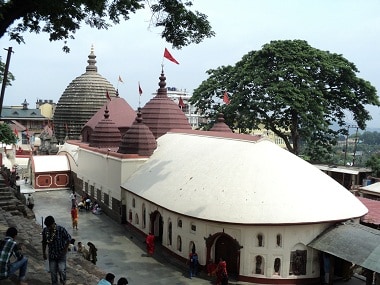Known as one of the most important centres for tantric practices, the Kamakhya Temple at the 800-feet-high Nilachal hill in west Guwahati skirted by the mighty Brahmaputra river is steeped in mystery and closely-guarded secrets. Its ancient lineage and standing as a centre of tantric practices only enhances that. On 19 June, that mystery got a fresh twist with the discovery of the headless, semi-naked body of a woman, about 40 years of age. Photos of the death scene showed the headless corpse lying on the concrete stairs and covered with a red floral blanket leading to the main Kamakhya Temple. An extinguished earthen lamp lay nearby but surprisingly, no blood or any trace of it was seen. [caption id=“attachment_3500515” align=“alignleft” width=“380”]  File image of the Kamakhya temple in Guwahati. Image courtesy: Wikimedia Commons[/caption] While a few called it a murder, for many it was a human sacrifice to please the Mother Goddess known for her ferocious disposition. For a few individuals who frequent Kamakhya Temple and are avid students of tantricism — the esoteric and mystic side of Hinduism and Buddhism — the death was not out of the ordinary. “Many believe that every year during Ambubasi, a human sacrifice (narabali) takes place. And that is possibly what happened this time too. There is also this belief that it is a voluntary self-sacrifice. The individual who is sacrificed offers to lay down his or her life voluntarily,” a practitioner of tantric rituals who is familiar with the happenings at Kamakhya told Firstpost on the condition of anonymity. While the belief is consistent with local folklore, there is no way to substantiate such claims. But there is no doubt that a lot of what happens at Kamakhya is shrouded in total secrecy in keeping with tantric traditions. It is in accordance with these beliefs that the timing of the death is significant. The time of the year just before the Ambubasi event, the seventh day of the month of Ahaar (May-June) of the lunar calendar, is the time that Goddess Kamakhya is believed to go through her menstrual cycle. And because of which, believers say, the water of the natural spring at the sanctum sanctorum of the famed temple turns reddish in colour. The scientific minded attribute the red colour to the iron-rich soil that mixes with the water which is seen inside the sanctum sanctorum or ‘garbha griha’ of the Kamakhya Temple. For three to four days of Ambubasi, the temple is closed to the outside world. But just after this period begins a period of cleansing or purification which is marked by the famous Ambubasi mela or congregation, which attracts upto 25 lakh people, including holy men and tantrics of all schools and denominations. This is a period of supreme significance for followers of tantricism when adherents believe that sacrifices and observance of certain rituals lead to acquisition of unbelievable and extraordinary powers. In a strongly-held belief that is totally unique to Assam, during the Goddess’ menstrual cycle called xaat loga in Assamese, all Hindu religious ceremonies and daily religious rituals across the state come to a stop. No evening prayers are held nor the devotional earthen lamp is lit, no farmer tills his land nor plants any seed, no fruits are plucked nor any auspicious event is held, for these three days are the days when Mother Earth is believed to be menstruating. Hindu religious beliefs in Assam which saw a strong interface and intermixing of Hindu beliefs with local tribal traditions are quite different from the rest of the country. That is why tantricism found fertile ground to grow and spread in Assam. And Kamakhya became one of the main centres of the worship of Shakti. While one school of thought supported by local folklore says the temple was a place revered by the Khasi tribe of Meghalaya, historians say the Kamakhya Temple was patronized by the 10th century Pala kings of Kamarupa, who were practitioners of Vajrayana or tantric Buddhism. The Palas were succeeded by the Senas who were avid followers of the Shakti cult of worship of the Mother Goddess and it was under their tutelage that Kamakhya acquired fame as a tantric centre. In The Journal of Hindu Studies by Ohio State University’s Professor Hugh B Urban, the Khasis honoured Goddess of the World Ka Blei Synshar, while the Jaintias worshipped a powerful form of Durg with blood sacrifice at her temple in Nartiang, Meghalaya. The Chutiya (Sutiya) kings, who ruled eastern Assam from the thirteenth to the sixteenth centuries, were known for their worship of the terrible goddess Kesaikhati, “who eats raw flesh, and her temple near Sadiya was infamous for the offering of human sacrifice”. Human sacrifice was a definite tradition even in medieval Assam and many old Hindu texts like the Yogini tantra and the Kalika Purana talk about it at length. Writes noted historian Dr Padmeswar Gogoi of living human burials during the Ahom dynasty’s 600 year rule in Assam, “The practice of giving living human attendants, both male and female, to be buried with the dead king was abolished by king Rudra Singha as advised by his father, the deceased king Gadadhar Singha, in a dream.” Sukhrungphaa or King Rudra Singha ruled Assam from 1696–1714. While sacrifice of animals and birds are a regular feature at Kamakhya even today, symbolic sacrifices of human beings are known to take place albeit in secret ceremonies. The discovery of the headless body is a possible pointer to the fact that the practice of sacrificing human beings at the altar of the Goddess has perhaps not ended in one of the most important tantric centres in the country.
The Kamakhya Temple in Guwahati is steeped in closely-guarded secrets and on 19 June, that mystery got a fresh twist with the discovery of the headless, semi-naked body of a woman, about 40 years of age
Advertisement
End of Article


)

)
)
)
)
)
)
)
)



